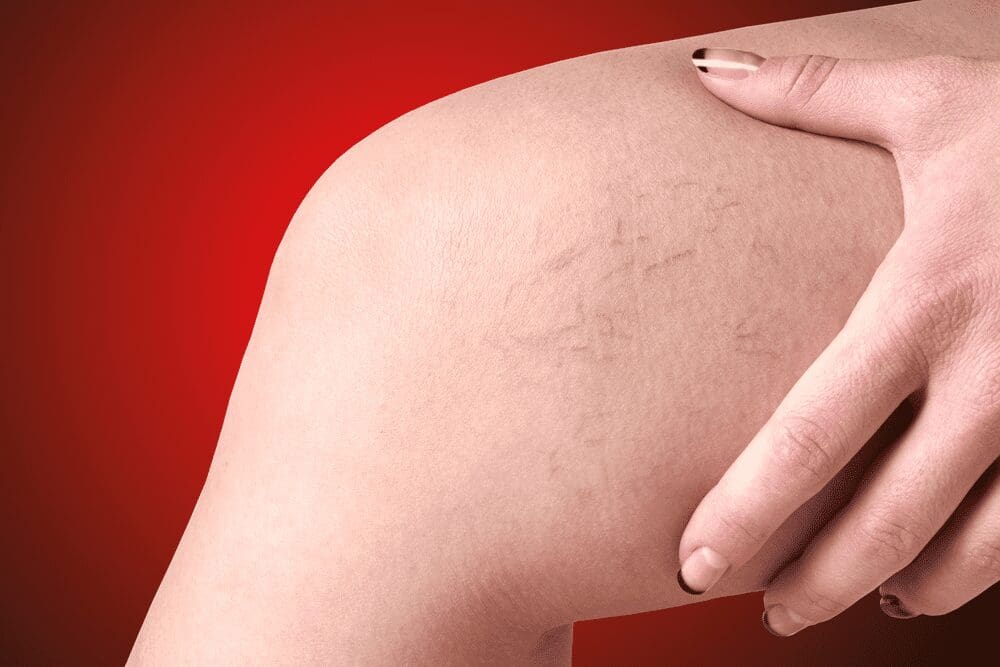Up to 55% of women and 45% of men have spider veins. This condition is caused by faulty valves and weak vein walls, and while it isn’t usually life-threatening or dangerous, it can be an esthetic issue. At North Texas Vein and Vascular in Flower Mound, TX, we offer a minimally invasive spider vein treatment called sclerotherapy to patients who would like to regain their smooth and beautiful legs.
Can You Permanently Treat Spider Veins?
Permanently treating spider veins is quite easy with sclerotherapy. Treatment is quick, minimally invasive, and highly effective. During your session, we’ll inject a chemical called sclerosant into the affected veins. This will cause the vein walls to collapse, so no blood can travel through them anymore. Over time, your body will absorb and secrete the broken veins.
People with spider veins located in one area of the body might only need to come to the clinic once, but those with multiple treatment sites might have to return several times. Each appointment only takes a few minutes, and you can leave right after. We might suggest that you take it easy for a few days, but you won’t have to rest or take time off work for several weeks after sclerotherapy.
How Do I Prepare and Recover from Treatment?
One of the reasons why this treatment is so popular is that there is very little preparation and recovery time. To get ready for your sclerotherapy appointment, you’ll need to shower and wash your legs with antibacterial soap, eat a nutritious meal, stay hydrated, and wear loose-fitting clothes. Don’t shave on the day of your appointment, and avoid drinking alcohol for at least two days beforehand.
After treatment, we recommend that you wear compression stockings for several days or weeks. However, you won’t have to rest for more than a few hours. The day after treatment, you can resume work and your regular routine, as long as it doesn’t involve strenuous physical activity. You won’t be able to take hot baths, sit in a hot tub or sauna, and apply hot compresses to your treatment area for a few days.
Do I Need Spider Vein Treatment?
Not everybody needs to get their spider veins removed. If you’re not bothered by their appearance, and they aren’t causing you any pain, you don’t need to come to the clinic. Sometimes, spider veins occur during pregnancy, but they disappear once the child is born. It’s important to have diseased veins treated as soon as they become painful because they could restrict mobility and prevent you from taking part in your regular activities.
Sometimes, patients with varicose veins develop spider veins due to the increased pressure on the tissues in their lower legs. In this case, seeing a vein specialist is important because severe varicosities can cause complications like ulcers, bleeding, and blood clots. These issues often don’t go away without treatment, so it’s best to avoid them by getting the spider and varicose veins removed.
Do Spider Veins Turn Into Varicose Veins?
Patients sometimes come to the clinic with spider veins because they are worried that their condition will get worse. Spider veins can become more pronounced as time goes by, but they don’t always turn into varicose veins. The best way to find out whether you’re likely to suffer from varicose veins in the future is to book an appointment at the clinic. We’ll be able to examine your spider veins and tell you whether you need treatment.
What Holistic Treatment Methods Are There?
If your spider veins aren’t very large, and you’re not ready to get treated, we can suggest ways of managing your condition at home. Compression stockings are highly effective because the pressure helps to reduce swelling and pain. The stockings also encourage your blood to flow normally and prevent it from pooling in your legs.
Certain lifestyle changes can reduce pain and prevent more spider veins from forming on your legs. If your job requires a lot of standing or sitting, get up and walk around every few hours to boost your circulation. Elevate your legs whenever possible. Exercise regularly to strengthen your cardiovascular system, and eat healthy foods.
Are There Other Treatment Methods?
We don’t generally recommend treatments other than sclerotherapy for spider veins. However, patients suffering from this condition sometimes also have varicose veins. In this case, several types of treatment might be necessary. Some common options for people with varicosities include laser vein ablation, radiofrequency ablation, VenaSeal, and foam sclerotherapy.
Laser Vein Ablation
Endovenous laser vein ablation is a great option for patients with mild to moderate varicose veins. During an ELVA, the local tissues are anesthetized, and a laser device is inserted into the relevant vein.
As we pull the laser back out, energy is delivered to your tissues. This prompts the vein to collapse and close. Once treatment is over, blood can no longer flow through your broken vein, which is absorbed by your body. Like sclerotherapy, ELVA doesn’t cause any scarring or permanent damage. Because there are plenty of pathways for your blood to travel, your body won’t have trouble adapting to the loss of the diseased veins.
Radiofrequency Ablation
Radiofrequency ablation is very similar to laser vein ablation, but instead of a laser, radiofrequency energy is used. We often use ultrasound imaging to make sure we are applying the energy to the right spot. You’ll be conscious during your session, but the treatment area will be anesthetized. For this reason, you might have to ask a friend or family member to drive you home from the clinic, especially if your legs are being treated.
Most patients need one or two radiofrequency ablation sessions, especially if they only have a few affected veins. However, more sessions might be necessary if the person has severe varicose veins or if they have spider veins in multiple locations.
VenaSeal
VenaSeal is another minimally invasive treatment designed to remove varicose veins from the body. It is very similar to sclerotherapy because a substance that collapses the vein walls is injected into the affected tissues. However, the active ingredient in VenaSeal is a medical adhesive instead of a sclerosant.
Both VenaSeal and sclerotherapy are highly effective. It all depends on the patient’s preferences, individual situation, and the size of their veins. Sometimes, insurance coverage is another consideration. Although 98% of varicose and spider vein treatments are covered under insurance, some providers prefer one method over another.
Foam Sclerotherapy
If you have small spider veins, it’s unlikely that you’ll need foam sclerotherapy. However, you might benefit from this treatment if you have larger, bulging veins that are causing you pain. Foam sclerotherapy is usually guided by an ultrasound, which allows us to see the diseased vein more clearly. Instead of a liquid, foam is injected into your tissues and prompts the vein to close.
Do I Need Surgery for Spider Veins?
Treatment for spider veins is almost always nonsurgical. Because this condition isn’t very serious, it can easily be treated with minimally invasive sclerotherapy. If you have both spider and varicose veins, we might start with ambulatory phlebectomy to remove the bigger veins.
This treatment involves making small incisions in your skin and pulling out the affected veins. It is done with local anesthesia, so you don’t have to stay at a hospital overnight. Once the large varicosities have been removed, we can treat the smaller spider veins with sclerotherapy.
Which Option Is Right for Me?
As you can see, there are plenty of options for people with varicose and spider veins. The best way to find out which ones you’re eligible for is to come to the clinic and have your condition assessed.
If you have spider veins, we’ll most likely suggest compression stockings, lifestyle changes, or sclerotherapy. Sometimes, we need to combine two or three methods to provide patients with the best results possible.
Will My Spider Veins Come Back?
Most people only have to come to the clinic once or twice to get their spider veins removed. After you’ve been treated, it’s unlikely that you’ll suffer from the condition again because the diseased veins have been removed from your body or absorbed. You’ll start to see results after a few weeks, but you might have to wait for three months until your legs are completely smooth.
Sometimes, spider veins come back if the underlying problem hasn’t been addressed. This might be the case if a patient still spends many hours a day standing or sitting, they have a disease like venous insufficiency, they are overweight, or they lead a very unhealthy lifestyle. Sometimes, patients repeatedly suffer from spider veins due to genetic factors.
Get Rid of Your Spider Veins Now
People often want to get rid of spider veins for aesthetic reasons or because the diseased veins are causing them pain. At the clinic, we usually recommend sclerotherapy, a minimally invasive method that involves the injection of a chemical called sclerosant. Treatment is almost always permanent. Call us at North Texas Vein and Vascular in Flower Mound, TX to find out more about spider vein treatment.
(Hello, sorry about this. Is it ok like this now? I have kept some info about varicose veins because the conditions often occur at the same time but have added a lot more about spider veins.)

